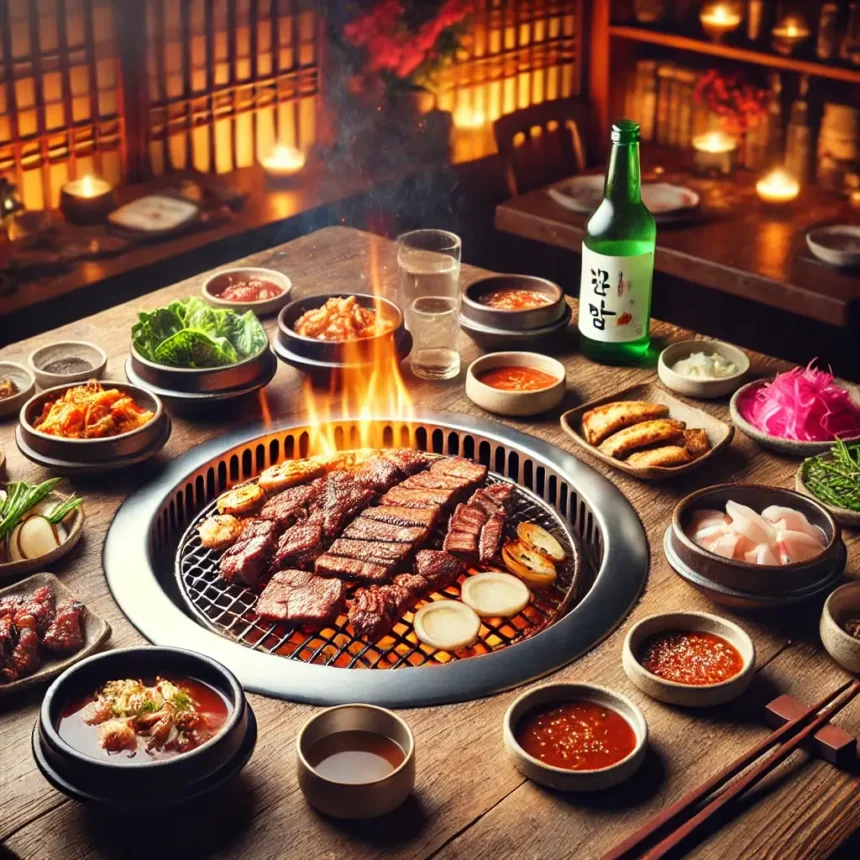Korean BBQ, a mouth-watering experience that brings people together around a grill, is more than just a meal—it’s a cultural experience. This article will walk you through everything you need to know about Korean BBQ, from the types of meat to the unique side dishes that accompany it. Whether new to Korean BBQ or a seasoned pro, this guide will provide all the information you need to enjoy this flavorful cuisine.
What is Korean BBQ?
Korean BBQ, known as “gogi-gui” in Korea, is a popular method of grilling meat, typically right at the table. The diners cook their meat on a grill, often built into the table, and enjoy it with various side dishes known as “banchan.” This communal dining style encourages social interaction as everyone gathers around the grill to cook and eat together.
The History of Korean BBQ
Korean BBQ has deep roots in Korea’s history. It evolved from ancient grilling practices where people cooked meat over an open flame. Over time, it became a refined art form, with specific techniques and ingredients that highlight the meat’s natural flavors. Today, Korean BBQ is enjoyed worldwide and celebrated for its unique flavors and the fun, interactive dining experience it offers.
Different Types of Meat in Korean BBQ
One of the most exciting aspects of Korean BBQ is the variety of meats you can enjoy. Here are some of the most popular types:
Samgyeopsal (Pork Belly)
Samgyeopsal is the most beloved Korean BBQ dish. Thick slices of pork belly are perfectly grilled, with a crispy exterior and tender, juicy interior. It’s typically enjoyed with a dipping sauce made of sesame oil, salt, and pepper.
Bulgogi (Marinated Beef)
Bulgogi, or “fire meat,” is thinly sliced beef marinated in a sweet and savory sauce made from soy sauce, sugar, garlic, and sesame oil. The marinade infuses the meat with a rich flavor, making it a favorite among many Korean BBQ lovers.
Galbi (Short Ribs)
Galbi refers to beef short ribs marinated in a sauce similar to bulgogi. The meat is cut across the bone, allowing faster cooking and easy eating. The result is a tender, flavorful dish that’s perfect for grilling.
Dak Galbi (Spicy Chicken)
For those who enjoy a bit of spice, Dak Galbi is a must-try. This dish consists of chicken marinated in a spicy sauce made from gochujang (Korean chili paste), garlic, and soy sauce. The chicken is grilled until it’s perfectly charred and juicy.
Chadolbaegi (Beef Brisket)
Chadolbaegi is a thinly sliced beef brisket that cooks quickly on the grill. It’s usually unseasoned, allowing the beef’s natural flavor to shine through. For an added kick, it’s often dipped in a mixture of soy sauce and wasabi.
Essential Side Dishes (Banchan) in Korean BBQ
No Korean BBQ experience is complete without banchan, the small side dishes accompanying the grilled meat. These dishes add variety and enhance the overall meal. Here are some common banchan you’ll encounter:
Kimchi
Kimchi, Korea’s famous fermented cabbage, is a staple at any Korean BBQ. It’s spicy, tangy, and packed with flavor. Kimchi’s bold taste complements the richness of grilled meat.
Japchae
Japchae is a sweet and savory dish made from stir-fried glass noodles, vegetables, and sometimes meat. Its slightly sweet flavor provides a nice contrast to the savory grilled meats.
Pickled Radishes
Pickled radishes, known as “musaengchae,” are crunchy and slightly tangy. They serve as a refreshing palate cleanser between bites of meat.
Ssamjang (Dipping Sauce)
Ssamjang is a thick, flavorful dipping sauce made from gochujang, doenjang (fermented soybean paste), garlic, and sesame oil. It’s perfect for adding an extra layer of flavor to your grilled meat.
Lettuce Leaves
Lettuce leaves are often used to make “scam” or wraps. Place a piece of grilled meat in the leaf, add some ssamjang and perhaps a bit of rice, then wrap it all up and enjoy. It’s a delicious and healthy way to eat Koreans BBQ.
The Art of Grilling: How to Cook Your Meat
Grilling the meat is one of the most enjoyable parts of the Korean BBQ experience. Here are some tips to help you get the perfect cook on your meat:
Preheat the Grill
Before you start cooking, make sure the grill is hot. This will help sear the meat and lock in its juices.
Don’t Overcrowd the Grill
Cook a few pieces of meat at a time. Overcrowding the grill can lower the temperature, causing the meat to steam instead of the grill.
Flip Sparingly
Let the meat cook on one side before flipping it. This helps achieve a lovely, even search. For thin cuts like chadolbaegi, you only need to cook it briefly on each side.
Rest the Meat
After grilling, let the meat rest for a minute or two. This redistributes the juices, making the meat more flavorful and tender.
Korean BBQ Etiquette: Dos and Don’ts
When dining out at a KoreanBBQ restaurant, it’s essential to follow some basic etiquette to ensure a pleasant experience for everyone:
Do Share the Grill
Koreans BBQ is a communal experience, so share the grill space with your dining companions. Cook a variety of meats so everyone can enjoy different flavors.
Don’t Overload Your Plate
Taking small portions at a time is polite, leaving enough for others to enjoy. You can always go back for more.
Do Use the Lettuce Wraps
Lettuce wraps are a great way to enjoy the grilled meat. They add a refreshing crunch and help balance the richness of the meat.
Don’t Leave Meat Unattended
Keep an eye on the meat as it grills. Overcooked meat can become tough and dry, so remove it from the grill when it’s done.
Do Engage in Conversation
Korean BBQ is as much about the social experience as the food. Take the time to chat and enjoy the company of your dining companions.
Korean BBQ at Home: How to Set Up Your Grill
If you want to enjoy KoreansBBQ at home, it’s easier than you think. Here’s how to set up your grill for a perfect at-home experience:
- Choose the Right Grill
For KoreanBBQ at home, you’ll need a tabletop grill. Electric grills are popular because they’re easy to use and control. You can also use a portable gas grill if you prefer.
Prepare Your Ingredients
Slice your meats thinly so they cook quickly. Prepare your banchan so everything is ready to go when you start grilling.
Ventilation is Key
Grilling indoors can produce a lot of smoke, so make sure your cooking area is well-ventilated. Open windows and use a fan to help clear the air.
Set the Table
Set your table with all the necessary items: grill, utensils, dipping sauces, and banchan. Make sure everyone has easy access to the grill.
Enjoy the Experience
Cooking at the table is part of the fun, so take your time and enjoy the process. Korean BBQ is meant to be savored with good food and good company.
Popular Korean BBQ Restaurants Around the World
Koreans BBQ has become a global phenomenon, with restaurants in major cities worldwide. Here are some popular spots where you can enjoy an authentic KoreanBBQ experience:
Kang Ho Dong Baekjeong (Los Angeles, USA)
This restaurant is famous for its lively atmosphere and high-quality meats. It’s a must-visit for anyone in LA looking to enjoy Korean BBQ.
Wangbijib (Seoul, South Korea)
Located in the heart of Seoul, Wangbijib offers a traditional Korean BBQ experience with a modern twist. The meat is top-notch, and the banchan are plentiful.
Charcoal Pot BBQ (Sydney, Australia)
Charcoal Pot BBQ is known for its extensive menu and authentic flavors. The restaurant uses traditional charcoal grills to give the meat a smoky, rich taste.
Yakiniku Jumbo (Tokyo, Japan)
While technically a Japanese BBQ restaurant, Yakiniku Jumbo offers a similar experience to Korean BBQ. The high-quality meats and attentive service make it a popular spot in Tokyo.
Superstar BBQ (London, UK)
Superstar BBQ is a trendy spot in London known for its modern take on Korean BBQ. The restaurant offers a variety of meat and vegetarian options.
Korean BBQ: A Healthy Option?
Korean BBQ can be a healthy dining option if you make the right choices. Here’s how you can enjoy Korean BBQ while keeping it nutritious:
Choose Lean Meats
Opt for lean cuts of meat like chicken or beef brisket instead of fatty options like pork belly. Lean meats are lower in calories and saturated fat.
Load Up on Vegetables
Take advantage of the lettuce wraps and banchan, which often include a variety of vegetables. These add fiber and nutrients to your meal.
Watch Your Portions
It’s easy to overeat at Korean BBQ because of its delicious food. Try to eat slowly and be mindful of your portions.
Avoid Sugary Sauces
Some KoreanBBQ sauces can be high in sugar. Use them sparingly, or choose healthier dipping options like soy sauce or vinegar-based sauces.
Korean BBQ for Vegetarians and Vegans
While KoreanBBQ is traditionally meat-heavy, there are plenty of options for vegetarians and vegans. Here’s how you can experience KoreanBBQ without the meat:
Grilled Vegetables
Many Korean’s BBQ restaurants offer a variety of vegetables for grilling, such as mushrooms, zucchini, and sweet potatoes. These can be just as satisfying as the meat options.
Tofu and Tempeh
Tofu and tempeh are great plant-based protein options. They absorb flavors well and can be grilled to perfection.
Banchan
Banchan often includes vegetarian-friendly dishes like pickled vegetables, kimchi (made without fish sauce), and seasoned greens.
Vegan Sauces
Ask for vegan-friendly sauces, as some traditional sauces may contain fish sauce or other animal products. Many restaurants are happy to accommodate dietary restrictions.
Korean BBQ: A Social Dining Experience
One of the best things about KoreanBBQ is the social aspect. It’s a meal to be shared, perfect for gatherings with friends and family. The interactive nature of cooking your food at the table encourages conversation and bonding. Whether celebrating a special occasion or enjoying a night out, KoreanBBQ provides a memorable dining experience.
Korean BBQ and Korean Culture
Koreans BBQs is more than just a meal—it reflects Koreans culture. The emphasis on sharing food, the importance of banchan, and the communal grilling all highlight the value Koreans place on community and togetherness. Eating Korean BBQ gives you a taste of this rich cultural tradition, making it more than a culinary experience.
How to Choose a Korean BBQ Restaurant
If you’re new to Koreans BBQ, choosing the right restaurant can be overwhelming. Here are some tips to help you find the best spot:
Check the Menu
Look for a restaurant that offers a variety of meats and banchan. An excellent KoreanBBQ spot will have many options to satisfy different tastes.
Read Reviews
Check online reviews to see what other diners have to say about the quality of the food and the service. Restaurants with consistently high ratings are usually a safe bet.
Consider the Atmosphere
Koreans BBQ is a social experience, so choose a restaurant with a lively, welcoming atmosphere. A crowded restaurant is often a sign of good food!
Ask for Recommendations
Ask friends or locals for recommendations if you need help figuring out where to go. They may know of hidden gems you wouldn’t find alone.
The Future of Korean BBQ
Korean BBQ continues to grow in popularity, with new restaurants and variations constantly popping up. From fusion dishes that blend Korean BBQ with other cuisines to vegetarian and vegan-friendly options, the future of Koreans BBQs is bright. As more people discover the joys of this interactive dining experience, KoreanBBQ will likely become even more widespread and beloved worldwide.
Korean BBQ at Home: Tips for a Successful Meal
If you decide to host a KoreanBBQ at home, here are some tips to ensure it goes smoothly:
Prep Ahead
Prepare all your ingredients ahead of time, including marinating the meat and setting out the banchan. This will make the actual cooking process much more manageable.
Keep It Simple
Don’t feel like you have to make every dish from scratch. Many Korean grocery stores sell pre-made banchan and marinades, saving you time and effort.
Get Creative
Feel free to experiment with different meats, vegetables, and sauces. KoreanBBQ is about enjoying the process, so don’t be afraid to try new things.
Enjoy the Moment
Remember, Korean BBQ is meant to be a fun, social experience. Take your time, enjoy the food, and savor the time spent with your friends and family.
FAQs
Q: What is Korean BBQ?
A: Korean BBQ is a popular dining style where diners grill their meat at the table, often accompanied by various side dishes called banchan.
Q: What meats are commonly used in Korean BBQ?
A: Typical meats include pork belly (samgyeopsal), marinated beef (bulgogi), short ribs (galbi), spicy chicken (dak galbi), and beef brisket (chadolbaegi).
Q: What are banchan?
A: Banchan are small side dishes served with Korean BBQ. They include kimchi, pickled radishes, japchae (stir-fried noodles), and dipping sauces.
Q: Is Korean BBQ healthy?
A: Korean BBQ can be healthy if you eat lean meats and vegetables and watch your portions. Avoiding sugary sauces also helps.
Q: Can vegetarians enjoy Korean BBQ?
A: Yes, vegetarians can enjoy Korean BBQ by grilling vegetables, tofu, and tempeh and eating the many vegetarian-friendly banchan.
Q: How do I choose an excellent Korean BBQ restaurant?
A: Look for a restaurant with a varied menu, good reviews, and a lively atmosphere. Recommendations from friends or locals can also be helpful.
Conclusion
Koreans BBQ is more than just a meal—a culinary adventure combining delicious flavors with a unique, interactive dining experience. From the rich history and variety of meats to the essential side dishes and dining etiquette, there’s much to appreciate about this beloved tradition. Whether you’re enjoying Korean BBQs at a restaurant or in the comfort of your own home, the key is to savor the moment, enjoy the company, and immerse yourself in the cultural experience that Korean BBQ offers.
With its growing popularity worldwide, Korean BBQ continues to bring people together over great food and conversation. So, consider trying Korean BBQ next time you’re looking for a fun, flavorful meal. It’s an experience that will surely satisfy you and your taste buds.









